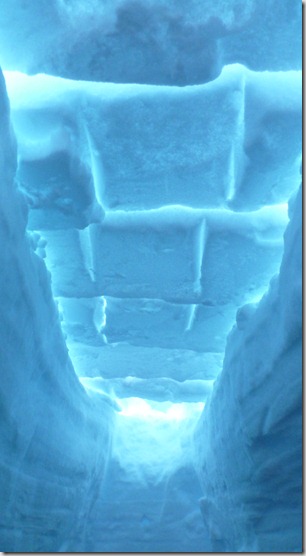 I awoke to silence and an oddly blue linear pattern of light above my head. Within moments I realized that I was buried under 5 feet of snow and was thousands of miles from civilization on the Ross Ice Shelf, but panic did not set in. Rather, I was filled with satisfaction knowing that I had spent a successful night in a weather-proof snow trench that I constructed the previous evening as part of Happy Camper School.
I awoke to silence and an oddly blue linear pattern of light above my head. Within moments I realized that I was buried under 5 feet of snow and was thousands of miles from civilization on the Ross Ice Shelf, but panic did not set in. Rather, I was filled with satisfaction knowing that I had spent a successful night in a weather-proof snow trench that I constructed the previous evening as part of Happy Camper School.
A week prior, I arrived in the tiny outpost of McMurdo station on the very edge of Antarctica and so far my experiences have varied from the inescapable monotony of trainings and briefings to the unexpected rip-roaring New Year’s Eve hoe-down called Ice Stock to productive scientific work and of course to spending two days camping on the ice shelf. My time thus far in McMurdo has left me buzzing from one thing to the next with little time for rest or quiet, but with countless opportunities to observe a world that is both foreign and familiar.
Since Antarctica resides on the dust-free side of the globe and has no entrants in the Olympics, it goes largely unnoticed by most of the world and is regarded as a mysterious land akin to Atlantis or another planet. Assuming you haven’t spent your evenings brushing up on Antarctic geography and history, I feel it is worthwhile to provide a little context on this continent. First off, it is a polar landmass that contains the majority of Earth’s fresh water ice on an actual continental plate at the south end of the world which contrasts greatly with the Arctic (northern) pole that is comprised of sea ice that is floating on the northern oceans. Second, it is the only continent which has no nations, although seven countries have staked sovereign claims to various longitudinal slices of the continent. This, combined with its extreme weather, lack of significant indigenous fauna and flora, and remote location have rendered it a continent of almost zero population. The people who do spend time on the continent are typically here for one of two reasons: to conduct scientific research or to support the scientists. Experiments are conducted throughout the continent in temporary field camps and at a handful of permanent research stations. The United States Antarctic Program (USAP) is a branch of America’s National Science Foundation (NSF) and represents the largest presence of any nation in Antarctica. USAP maintains 3 permanent research stations: South Pole Station, Palmer Station, and McMurdo Station. The location of the South Pole Station is equally obvious and awe-inspiring given the extreme cold and isolation; Palmer Station is located on the Palmer Peninsula, which is the long finger that reaches up towards the southern tip of South America; and finally, McMurdo is located almost diametrically opposite from Palmer at the edge of the Ross Sea and 2600 miles due south of New Zealand. Its exact location is on the edge of Ross Island just off the coast of the main continent in a historic location that was readily accessible by sea for the early Antarctic explorers.
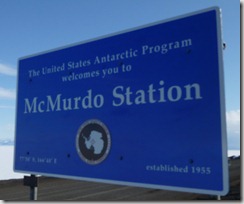 McMurdo is by far the largest of the Antarctic research stations with a summer population of 1000 and the largest collection of logistical resources. Prior to my arrival I read several accounts of Antarctica and McMurdo but Werner Herzog’s acclaimed documentary, Encounters at the End of the World, made the most significant impression on me. I knew that in addition to the obvious natural wonder that I would experience, the societal aspects of McMurdo would be worthy my attention during my 6 weeks in the small town. Countless times, I heard McMurdo described not as an exotic glaciated camp but as a grimy mining town you would expect to find in Alaska. If fact, this is a wonderful description, but its worth noting why this is the case. The specific site is on snow-free, solid volcanic land that is adjacent to sea ice that melts every summer providing seafaring access to resupply ships, and if you are looking to build permanent structures in Antarctica, those are two of the best characteristics you could hope for in a station site. Furthermore, although Ross Island is not technically connected to the main continent, it is effectively attached via the permanent Ross Ice Shelf that permits year-round ground travel to other locations. While the town setting is not particularly attractive, Mount Erebus (12,448’) dominates the view looking back along Ross Island while the TransAntarctic mountain range occupies the space above the sea shelf and sea ice in front of town. Without a doubt, the views are stunning.
McMurdo is by far the largest of the Antarctic research stations with a summer population of 1000 and the largest collection of logistical resources. Prior to my arrival I read several accounts of Antarctica and McMurdo but Werner Herzog’s acclaimed documentary, Encounters at the End of the World, made the most significant impression on me. I knew that in addition to the obvious natural wonder that I would experience, the societal aspects of McMurdo would be worthy my attention during my 6 weeks in the small town. Countless times, I heard McMurdo described not as an exotic glaciated camp but as a grimy mining town you would expect to find in Alaska. If fact, this is a wonderful description, but its worth noting why this is the case. The specific site is on snow-free, solid volcanic land that is adjacent to sea ice that melts every summer providing seafaring access to resupply ships, and if you are looking to build permanent structures in Antarctica, those are two of the best characteristics you could hope for in a station site. Furthermore, although Ross Island is not technically connected to the main continent, it is effectively attached via the permanent Ross Ice Shelf that permits year-round ground travel to other locations. While the town setting is not particularly attractive, Mount Erebus (12,448’) dominates the view looking back along Ross Island while the TransAntarctic mountain range occupies the space above the sea shelf and sea ice in front of town. Without a doubt, the views are stunning.
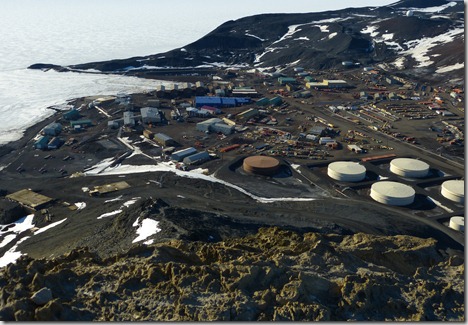 The town itself is an eclectic mix of buildings that seem to be haphazardly placed on the volcanic rock as if tossed out by Erebus itself. Dormitories, two small bars, the Coffee House, a gymnasium, the Chapel of the Snows, and the galley all compete for the resident’s free time, but the business side of the station dominates the area. The station’s center piece, the Crary Lab, is the heart of the Antarctic scientific community and is proudly built on the hillside looking out at the TransAntarctic Mountains. It is a state of the art laboratory with technical resources, labs, and office space for the hundreds of visiting scientists who base their research in McMurdo and who use the town as a launch pad for the remote field camps. The station has the feel of a university campus crossed with a military base and there are signs of this everywhere. Moving away from the university-esque Crary Lab, you find an entire support infrastructure right before your eyes with no place to hide on the bare volcanic grounds. Pipelines zigzag above ground to massive fuel tanks with millions of gallons of diesel, gasoline, and jet fuel while others carry waste heat to buildings and yet others carry waste liquid to the water treatment plant. Heavy equipment continuously drives the same dirt streets that residents walk on and provide support to three airfields on the ice and a heliport in town. There is a completely raw feel to it where science is the esthetic and architecture is not even an afterthought.
The town itself is an eclectic mix of buildings that seem to be haphazardly placed on the volcanic rock as if tossed out by Erebus itself. Dormitories, two small bars, the Coffee House, a gymnasium, the Chapel of the Snows, and the galley all compete for the resident’s free time, but the business side of the station dominates the area. The station’s center piece, the Crary Lab, is the heart of the Antarctic scientific community and is proudly built on the hillside looking out at the TransAntarctic Mountains. It is a state of the art laboratory with technical resources, labs, and office space for the hundreds of visiting scientists who base their research in McMurdo and who use the town as a launch pad for the remote field camps. The station has the feel of a university campus crossed with a military base and there are signs of this everywhere. Moving away from the university-esque Crary Lab, you find an entire support infrastructure right before your eyes with no place to hide on the bare volcanic grounds. Pipelines zigzag above ground to massive fuel tanks with millions of gallons of diesel, gasoline, and jet fuel while others carry waste heat to buildings and yet others carry waste liquid to the water treatment plant. Heavy equipment continuously drives the same dirt streets that residents walk on and provide support to three airfields on the ice and a heliport in town. There is a completely raw feel to it where science is the esthetic and architecture is not even an afterthought.
On my second evening, I hiked up Observation Hill and captured a dozen photographs that I stitched together into the 360 degree panorama seen below.
If you spend a few moments panning and zooming and have a keen eye, you just might be able to find the following local landmarks:
- This tribute to Captain Scott’s ill-fated trip to the South Pole is engraved with the words “To strive, to seek, to find, and not to yield.”
- The galley is the sole location for meals in McMurdo and chances are that the Smurfs would feel right at home in this building.
- Less than 2 miles away from McMurdo, New Zealand maintains Scott Base whose color you would expect from the Irish.
- The sea ice melts away for a few weeks each year right up to this location along the ice shelf. (Hint: it all looks like snow, but there is a clear delineation)
- The Kiwis and the Americans have recently begun to share this source of renewal power.
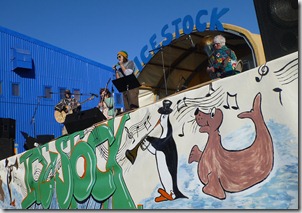 Within a day of our arrival, I had already met two of the residents who were prominently featured in Encounters at the End of the World, and I was excited to explore the social aspects of McMurdo myself. With great fortune, we showed up in town to crystal blue skies and balmy, 32 degree temperatures that provided an ideal environment to celebrate the coming of the New Year at the stations biggest annual party, Ice Stock. For over 6 straight hours, bands rocked atop a temporarily erected tractor trailer stage while hundreds of folks danced and partied like it was the last day of the year. Each of these groups demonstrated surprising talent and at least as much initiative as they pulled together musicians from the McMurdo ranks with a wide array of instruments to entertain the troops for just one day a year. The faces of these musicians were among the first I saw at McMurdo, and I feel a bit like Herzog as I encounter them dishing food and sweeping halls for I have seen a side of them that draws their passion like their day-to-day job can not.
Within a day of our arrival, I had already met two of the residents who were prominently featured in Encounters at the End of the World, and I was excited to explore the social aspects of McMurdo myself. With great fortune, we showed up in town to crystal blue skies and balmy, 32 degree temperatures that provided an ideal environment to celebrate the coming of the New Year at the stations biggest annual party, Ice Stock. For over 6 straight hours, bands rocked atop a temporarily erected tractor trailer stage while hundreds of folks danced and partied like it was the last day of the year. Each of these groups demonstrated surprising talent and at least as much initiative as they pulled together musicians from the McMurdo ranks with a wide array of instruments to entertain the troops for just one day a year. The faces of these musicians were among the first I saw at McMurdo, and I feel a bit like Herzog as I encounter them dishing food and sweeping halls for I have seen a side of them that draws their passion like their day-to-day job can not.
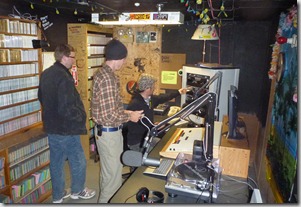 And in a particularly Herzogian encounter right after Ice Stock, Sam and I met two residents who spend their spare evenings running the local radio station and were thrilled to share the radio business with us. We wandered down the hall from the galley with Matt and Tristen and right into the live radio booth where Matt promptly interviewed me and Sam queued up Neil Young. While that was a real treat, things then got really interesting as they described the McMurdo vinyl record collection that was provided ages ago by the Air Force Radio and Television Service (AFRTS). With the advent of digital media, all AFRTS vinyl collections were slowly phased out and destroyed over the years and now the sole collection in in existence resides in McMurdo. Apparently, the only reason it has survived is that all garbage must be shipped back to the states from Antarctica and the cost of shipping the record collection has been considered to be too large. However with limited physical space around town, there is a looming threat that the collection will meet its demise in the near future and this history will be lost forever. And this is where the encounter took a great turn; Matt and Tristen would like to see the vinyl collection maintained as historical records and are working to see if they can receive an appropriate protected status that allow this Antarctic oddity to survive well into the future.
And in a particularly Herzogian encounter right after Ice Stock, Sam and I met two residents who spend their spare evenings running the local radio station and were thrilled to share the radio business with us. We wandered down the hall from the galley with Matt and Tristen and right into the live radio booth where Matt promptly interviewed me and Sam queued up Neil Young. While that was a real treat, things then got really interesting as they described the McMurdo vinyl record collection that was provided ages ago by the Air Force Radio and Television Service (AFRTS). With the advent of digital media, all AFRTS vinyl collections were slowly phased out and destroyed over the years and now the sole collection in in existence resides in McMurdo. Apparently, the only reason it has survived is that all garbage must be shipped back to the states from Antarctica and the cost of shipping the record collection has been considered to be too large. However with limited physical space around town, there is a looming threat that the collection will meet its demise in the near future and this history will be lost forever. And this is where the encounter took a great turn; Matt and Tristen would like to see the vinyl collection maintained as historical records and are working to see if they can receive an appropriate protected status that allow this Antarctic oddity to survive well into the future.
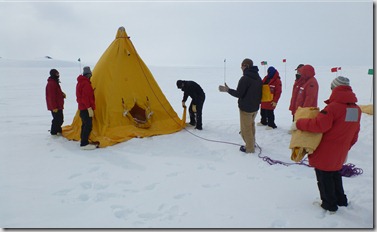 Our days are typically filled with the business at hand which will quickly turn to several helicopter supported day trips to remote locations to install the ozone instrument network in the field. However, regulations will not let you go to the field without proper survival training for this harsh environment, so Sam and I were required to attend a two day class that is affectionately called Happy Camper School. After a morning-long classroom session, our class of 10 students and 1 instructor boarded a monster truck-esque shuttle vehicle and bounced 4 miles away from McMurdo and out onto the Ross Ice Shelf. From there we hiked another half mile to a desolate location with dead flat snow for miles in every direction and began our training in earnest. We established a temporary camp where we erected tall, pyramid Scott tents whose design has not changed in a century, and then proceed to construct a chest high snow wall as a wind break. The wall was composed of perfectly rectangular chunks of styrofoam-like snow that were literally cut from the ground using a hand saw. The uniform composition of the snow is like nowhere else on Earth and it was amazing to use snow in this way without any additional compaction or treatment. After we established that we could provide simple camp for ourselves, we were offered extra credit. As we were building our wall, the instructor had been quietly digging out an 8 foot long trench that looked frighteningly similar to a human grave, and then he proceeded to tell us that if we wanted to, we could sleep in one of these snow trenches instead of our perfectly good tents. This all sounded pretty ridiculous to me, but to be fair, the usual goal of a snow trench is to provide an emergency shelter that is free from the deadly effects of high winds. After a few minutes of hand waving instruction on how to finish building a snow trench, he left us to fend for ourselves for the night. Never one to shy away from I challenge, I grabbed a shovel and spent the next 4 hours shoveling away until I had a comfortable sleeping chamber free from the wind, but covered in blocks of snow that seemed to be precariously suspended above my head. However, once I moved into my abode and spread out my gear, it took on the feel of a nest and I slept soundly throughout the night. The following morning, we broke camp and proceeded learn about VHF & HF radio usage and practice scenarios. The scenarios were not only instructive, but quite entertaining as we attempted to contact the South Pole using Korean War era radio equipment and then simulated white-out conditions with plastic buckets on our heads. I have always been one who loves to camp, and it’s pretty darn cool to be able to say that I am an Antarctic Happy Camper.
Our days are typically filled with the business at hand which will quickly turn to several helicopter supported day trips to remote locations to install the ozone instrument network in the field. However, regulations will not let you go to the field without proper survival training for this harsh environment, so Sam and I were required to attend a two day class that is affectionately called Happy Camper School. After a morning-long classroom session, our class of 10 students and 1 instructor boarded a monster truck-esque shuttle vehicle and bounced 4 miles away from McMurdo and out onto the Ross Ice Shelf. From there we hiked another half mile to a desolate location with dead flat snow for miles in every direction and began our training in earnest. We established a temporary camp where we erected tall, pyramid Scott tents whose design has not changed in a century, and then proceed to construct a chest high snow wall as a wind break. The wall was composed of perfectly rectangular chunks of styrofoam-like snow that were literally cut from the ground using a hand saw. The uniform composition of the snow is like nowhere else on Earth and it was amazing to use snow in this way without any additional compaction or treatment. After we established that we could provide simple camp for ourselves, we were offered extra credit. As we were building our wall, the instructor had been quietly digging out an 8 foot long trench that looked frighteningly similar to a human grave, and then he proceeded to tell us that if we wanted to, we could sleep in one of these snow trenches instead of our perfectly good tents. This all sounded pretty ridiculous to me, but to be fair, the usual goal of a snow trench is to provide an emergency shelter that is free from the deadly effects of high winds. After a few minutes of hand waving instruction on how to finish building a snow trench, he left us to fend for ourselves for the night. Never one to shy away from I challenge, I grabbed a shovel and spent the next 4 hours shoveling away until I had a comfortable sleeping chamber free from the wind, but covered in blocks of snow that seemed to be precariously suspended above my head. However, once I moved into my abode and spread out my gear, it took on the feel of a nest and I slept soundly throughout the night. The following morning, we broke camp and proceeded learn about VHF & HF radio usage and practice scenarios. The scenarios were not only instructive, but quite entertaining as we attempted to contact the South Pole using Korean War era radio equipment and then simulated white-out conditions with plastic buckets on our heads. I have always been one who loves to camp, and it’s pretty darn cool to be able to say that I am an Antarctic Happy Camper.
As usual, enjoy the photos in the slide show below and if you would like to open this slideshow in a new window, just click here.
For an additional perspective on the past week here, check out the following excellent posts from Sam Dorsi: Back From Happy Camper through Ridgeline North of McMurdo
